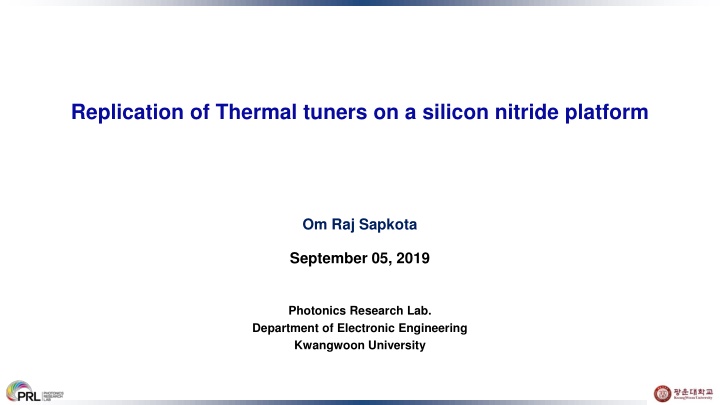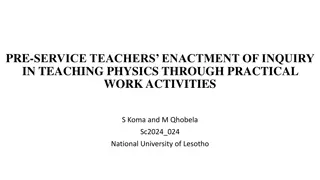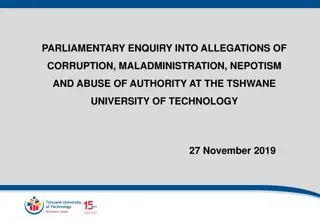
Replication of Thermal Tuners on Silicon Nitride Platform
Explore the replication process of thermal tuners on a silicon nitride platform, comparing expected and calculated temperature results using heat transfer in solids physics. Discover the suggested approach and potential examples to understand the physics involved.
Download Presentation

Please find below an Image/Link to download the presentation.
The content on the website is provided AS IS for your information and personal use only. It may not be sold, licensed, or shared on other websites without obtaining consent from the author. If you encounter any issues during the download, it is possible that the publisher has removed the file from their server.
You are allowed to download the files provided on this website for personal or commercial use, subject to the condition that they are used lawfully. All files are the property of their respective owners.
The content on the website is provided AS IS for your information and personal use only. It may not be sold, licensed, or shared on other websites without obtaining consent from the author.
E N D
Presentation Transcript
Replication of Thermal tuners on a silicon nitride platform Om Raj Sapkota September 05, 2019 Photonics Research Lab. Department of Electronic Engineering Kwangwoon University
Replication of previous works Purpose: We would like to replicate the temperature gradient result of the previous paper D. Perez., Thermal tuners on a silicon nitride platform, arXiv , 2016 Ref. https://arxiv.org/abs/1604.02958
Structure and parameter Table of parameters Item TSiO2 Tau Tcr We TSiN WSiN Tbox Tele Value 3.5 100 30 5 300 1 2 130 Unit um nm nm um nm um um nm Description Thickness of SiO2 Thickness of Au Thickness of Cr Width of electrode Thickness of SiN Width of SiN Thickness of BOX Tau+Tcr We Air Tele Electrode (Au and Cr) TSiO2 TSiN SiN Tbox BOX (SiO2) WSiN Si substrate Schematic diagram We designed the structure by using parameters written on the paper
Comparison of contour map of temperature ) Expected vs. Calculated Temperature [ C] No change Expected result Calculated result from COMSOL Min. Temperature Max. Temperature Expected 12 102 Totally different Calculated 25 25.08 - To apply the power (297.32 mW) to the electrode, we used the physics called Heat transfer in solids. (For the details, please refer to next slide) But, the result is totally different from the expected result of the paper. -
Used physics Heat transfer in solids Air Electrode (Au and Cr) SiO2 SiN Si The temperature at this boundary is set to T = 25 C We used electrode as a heat source and applied the power (297.62 mW) to the electrode (Au and Cr)
Comparison: Temperature range (Expected vs. Calculated) P0: 297.32 mW 275.45 W Temperature [ C] Change P = 297.62 mW Expected result Calculated result from COMSOL Min. Temperature Max. Temperature Expected 12 102 Calculated 27.66 102 - If we changed the P0of Heat Source from 297.32 mW to 275.45 W, we could see some changes in the result
Question From the calculated result, it looks we approached a wrong way to replicate the paper result. Is this right way to use physics Heat Transfer in solids ? Which physics do you suggest for this situation? If so, please let us know any example to understand that physics?






















